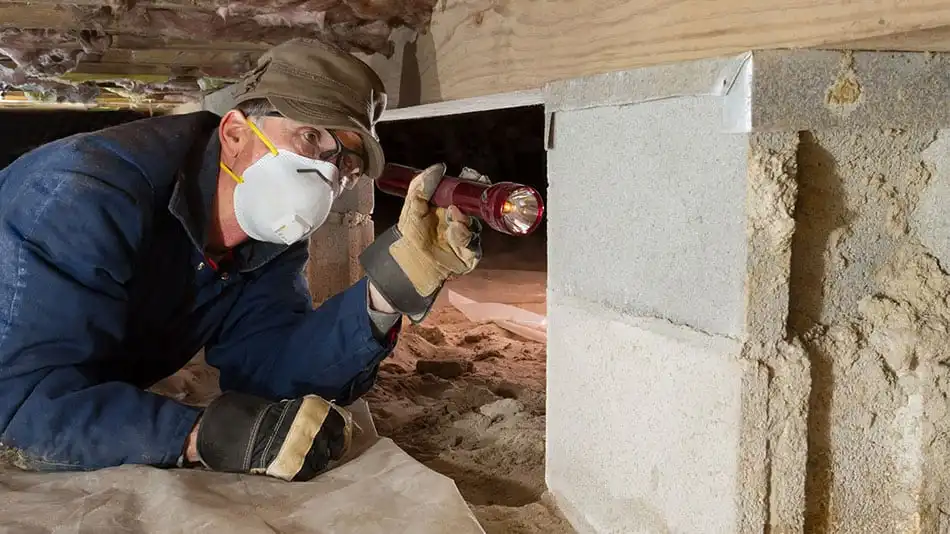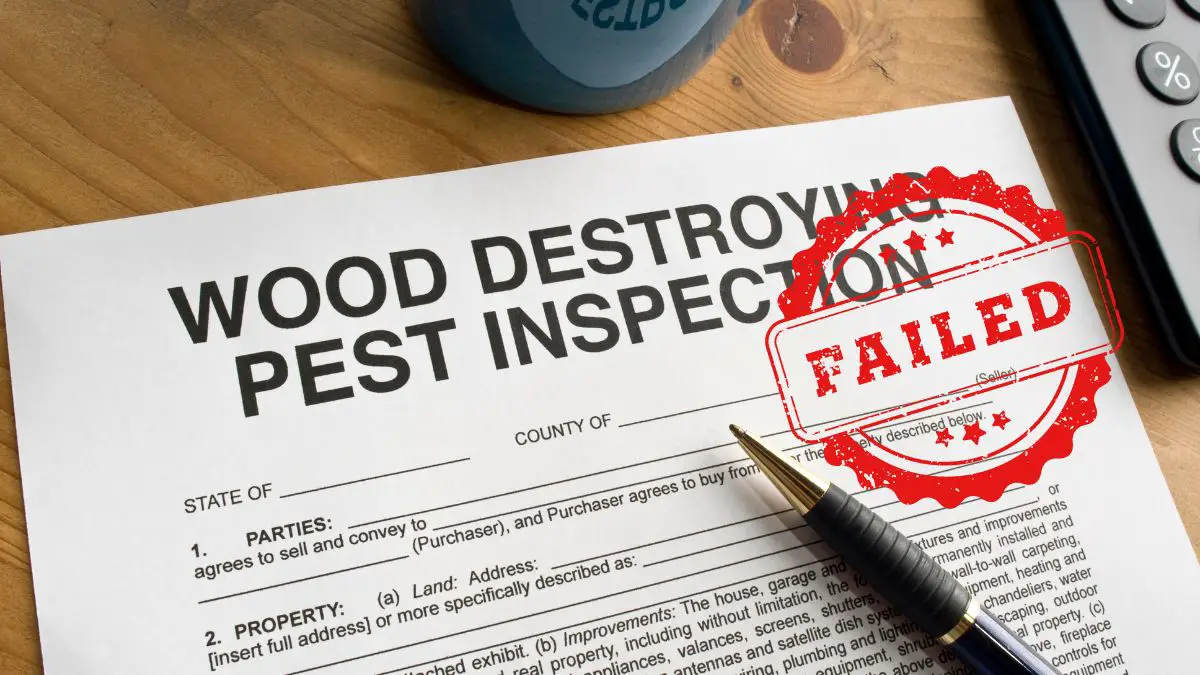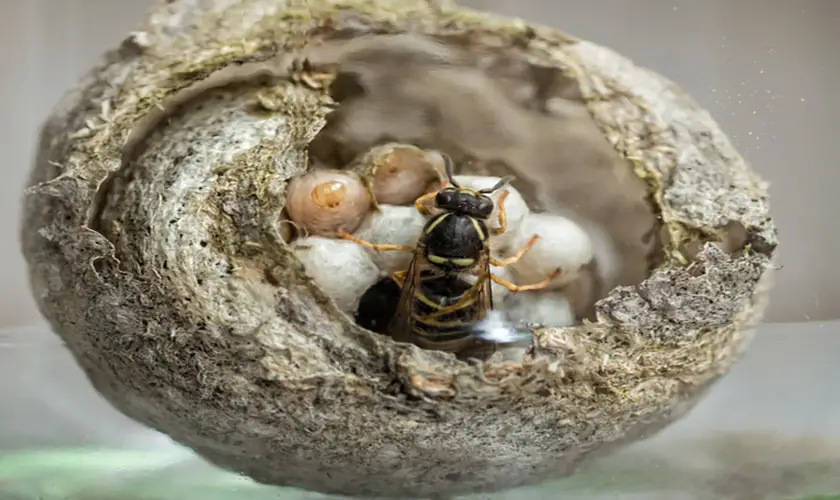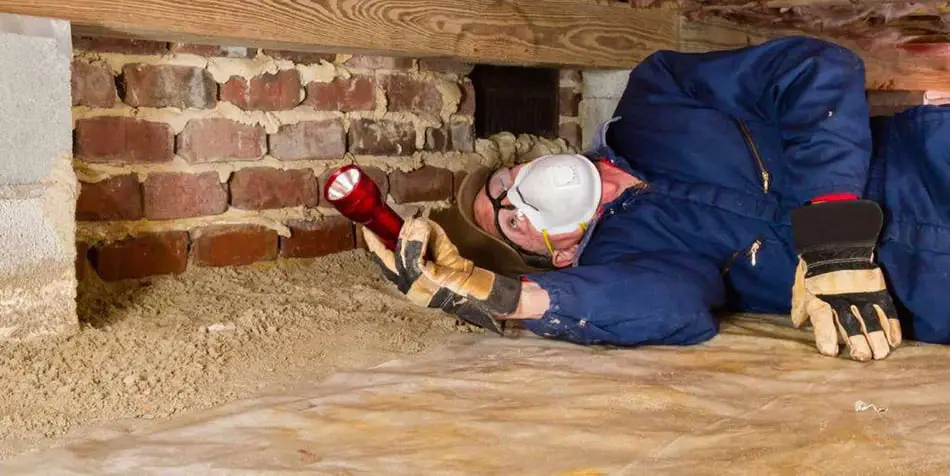
Hornets are the most significant type of eusocial wasps. They are closely related to yellowjackets and other kinds of social wasps. Solitary wasps don’t live in colonies and are unlikely to sting people.
The European hornet, a species introduced to the United States in the 19th century, used to be the only true hornet in the U.S. until the Asian giant hornet was sighted in December 2019 in Washington.
All facts aside, one might be wondering how you can get rid of hornets for good. Well, let us go through them together, shall we?
Here are the nine fastest ways to get rid of hornets:
- To call in professionals
- Kill them in spring
- Spray insecticide into the nest as they sleep
- Puff insecticide dust into the nest
- Set bait traps
- Use insecticidal gel
- Properly dispose of trash
- Set bucket traps
- Use yellow bulbs in outside lights
Get FREE quotes from licensed pest control technicians in your area today. Whether you need spraying for ants, roaches, spiders, ticks, mosquitos, or bed bugs, We Can Help! All technicians are screened, licensed, and insured.
Most of the 20 hornet species in the world live in tropical Asia, but hornets also occur in Africa, Europe, and North America.
To get rid of hornets effectively, knowing which insect you are dealing with is a good idea. Hornets are not generally aggressive and unlikely to sting if left alone, but they protect their nests.
The Fastest 9 Ways To Get Rid of Hornets
If you want to try and get rid of the hornets, ensure that you wear suitable protective clothing and don’t have any underlying medical conditions that might make you especially vulnerable if stung.
If a hornet’s nest is inaccessible from the ground, it is recommended that you call in a professional to exterminate them safely. Dealing with hornets is not for the fainthearted; if you mess up, you risk multiple stings.
It would be best if you used some of the methods described below in combination with others for the best results. If a hornet’s nest is too far away to represent a danger to household members, it is best to leave it there. Hornets benefit the environment, pollinate many plants, and prey on other insect pests.
So what are the best ways to get rid of them the fastest? Here they are once more:
- Kill them as they emerge in the spring with insecticidal sprays and traps before they can build nests.
- Spray insecticides especially formulated for wasps and hornets into the opening of nests.
- Blow insecticidal dust into the openings of their nests using bellows or powder pumps.
- Apply insecticidal gels to plants where insects are girdling to get at the sap.
- Call in professional pest control.
- Use bin liners, keep trash cans and dumpsters far away from the house, and regularly take out the trash.
- Sanitation – clean up food and drink spills; keep food and drink containers closed; pick up rotting fruit from around fruit trees; empty trash bins regularly; seal up cracks and crevices around the house; and prevent other insects hornets prey on from coming inside.
- Change the bulbs in outside lights to yellow LEDs or sodium vapor lights so as not to attract hornets and the insects they feed on. Install screens on windows and doors to prevent them from coming inside.
- Set up bucket or bottle traps around the nest or in fruit orchards that lure them in and drown them.
What’s The Difference Between Wasps, Hornets, and Yellowjackets?
People mistakenly call wasps hornets, especially in the United States, where no hornets occur naturally. The European hornet came to the U.S. with human settlers in the mid-1800s.
True hornets are differentiated from other wasps by a larger vertex and a rounded abdomen. The vertex is the part of the head behind the eyes.
European hornets have become widespread in the United States since their European introduction. True hornets belong to the Vespa genus, but other stinging insects are called ‘hornets.’
Yellowjackets don’t belong to the Vespa genus but are still sometimes referred to as hornets. The bald-faced hornet is a yellowjacket and not a true hornet because it does not belong to the Vespa genus.
Hornets prey primarily on other insects, including wasps and honeybees. Beekeepers hate them.
More recently, the Asian Giant hornet has attracted a lot of attention and has been called the ‘murder hornet.’ This insect is much more giant than other wasps and hornets in the U.S.
Paper wasps construct nests from finely chewed wood, and their saliva looks like they are made of paper. They like to locate the nest in protected areas, such as under the eaves or in barns, mailboxes, sheds, behind window shutters, or in porch lights.
Most paper wasps are reddish-brown, but the European paper wasp has black and yellow markings and could be mistaken for a hornet or a yellowjacket.
Wasps differ from hornets and yellow jackets because they have a narrow waist between the thorax and the abdomen. They will sting if you interfere with their nests but are not considered particularly aggressive.
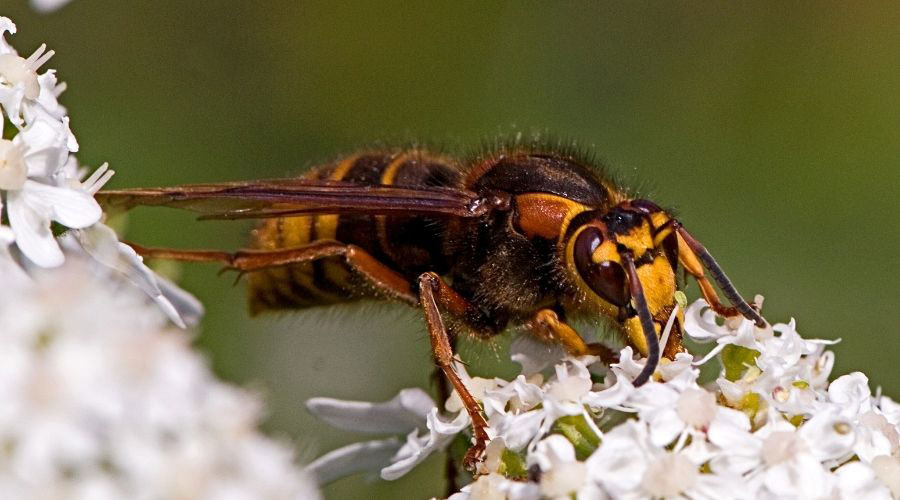
1. European Hornets
European hornets are more prominent than wasps, have fatter bodies, and are called brown or giant hornets. They are brown with large yellow or orange stripes on their abdomens and light-colored face. Their wings are dark. The adult females range from 1.8 to 2.4 centimeters, but the hornet queen can be bigger.
They usually live in woodlands, making their nests in hollow trees or other natural cavities higher than six feet from the ground. However, they have been known to nest in attics, barns, and wall voids.
These hornets occur in the eastern U.S., through to eastern Dakota and south in Illinois and Iowa down to New Orleans. Their larger size distinguishes them from yellowjackets.
The nest may contain between two hundred and four hundred worker hornets in late summer. Like bees, they play different roles in the colony, with some acting as guards that will attack any perceived threats to the nest. The guards will attack anyone or anything that comes too close.
Their Lifespan
European hornets have a short life cycle and die off when winter comes. Most workers will be dead by late fall, while a few fertile females survive to hide in sheltered places and await the spring.
The hornet queens emerge from their hiding places in early May to search for suitable nesting areas and restart the colony. The queen makes the nest’s first cells by chewing up wood and mixing it with her saliva.
Then she lays eggs in them and raises the first worker hornets to the point where they can take over further construction of the nest, caring for larvae and searching for food. Once this is done, her only role is laying more eggs to populate the colony.
European hornets mate in July after the queen has produced some fertile males and females. Only the fertilized females continue to survive the winter months and begin the cycle again.
They wait for the hornets to die off in the winter to remove the nest and to seal up any holes where it was built in the safest way to eliminate these hornets.
European hornets can be problematic if they nest in a hollow tree in the yard, attic, or wall void of a house since they vigorously defend the colony.
However, the nests are not re-used in the next season because the new hornet queen will build a new one.
Tips For Dealing With European Hornets
It is best to leave them be if they are out of the way of children, pets, and adults in and around the home.
The hornets are attracted by fruit trees in the fall because they want the sugary juices and chew through the skin to get at them.
This means that orchard workers harvesting the fruit are at risk from hornet stings, as are customers who attend outdoor farm markets.
Heavy gloves, taping over the top of boots and socks, and wearing bee-keepers veils and hats offer some protection.
If you have fruit trees growing in the garden, they can be a magnet for hornets, especially if you don’t harvest the fruit as soon as it is ripe.
Leaving the fruit that falls to the ground to rot is a sure way to attract hornets and other wasps. You can place traps in fruit trees to control them. This method works well for yellow jackets but may not be that effective for other wasps and hornets.
Traps that lure the hornets away from the trees, imprison them, or cause them to fall into the water in a bucket below, may work better.
European hornets are active at night, so change the bulbs in outside lights to yellow ones to avoid attracting them. Yellow LEDs have been shown to work even better than sodium vapor lamps.
Removing a European hornet nest yourself is not a good idea. It is better to call in professional pest control to evaluate the situation and see how best to remove and destroy the nest.
If European hornets are destroying flowering plants by stripping off the bark around the stems to get at the sap, you can apply gel bait to the damaged area.
The hornets suck it up and take it back to the nest, digested and then excreted it in the feces. This exposes a chemical that kills the members of the colony.
Trees or plants being damaged by these hornets can also be sprayed with an insecticide that insects pick up when they walk over it. They transfer it to their nest, exposing other hornets to it. It works as a contact poison, so any insect that comes into contact with it will die.

2. Asian Giant Hornets
The Asian giant hornet is the largest globally and is known to kill as many as fifty people yearly in Japan. They are the apiarist’s nightmare wherever they occur because they prey on honeybees, among other insects.
It was recently detected in Washington State in the U.S. and British Colombia in Canada, although it is native to Asia.
Scientific studies have shown that it could rapidly spread throughout western North America unless it is contained.
This is an immense environmental concern because the honeybees of Europe and North America are defenseless against them, unlike Japanese honeybees that have evolved methods of dealing with them.
Asian giant hornets eat many different insects and could have undesirable ecological consequences for native American species.
The Washington State Department of Agriculture encourages citizen scientists, land managers, and owners to share data on this invasive species.
They say that it will threaten agriculture, honeybees, and human health. Like other hornets, it is a social wasp, usually one and a half to two inches in length.
The Asian giant hornet has a large orange head, prominent eyes, and a black and orange or black and yellow striped abdomen. A queen can exceed five inches in length.
They have voracious appetites and are hard to detect because they build their nests in forested areas. In addition to injecting a hefty dose of venom with the sting, they can bite.
They can be more than three times the size of a bald-faced hornet. Asian giant hornets attack other wasp species and eat them.
Entomologists hope they won’t establish themselves in the U.S. because they lack the genetic diversity necessary to survive in hostile environments.
You can catch them in traps put out for other insects and hornets. The stings are excruciating and hurt for days. Asian giant hornets typically live in underground nests in holes dug by rodents or other animals or caused by rotted tree roots. However, scientists in Washington found a nest high in a tree cavity.
Never Tackle Them Yourself
A layperson should never tackle these hornets’ nests as a sting can be life-threatening to anyone allergic to their venom. Multiple stings can also be fatal.
The experts wear special suits to prevent stings. Because the stingers are so large, ordinary beekeepers’ suits may not be practical.
The nest looks similar to a wasp’s and might be found in sheds, the sides of buildings, and wood stores. The Asian giant hornet is not active at night, so it is more likely to be spotted in the day.
If you see a nest, call the experts to remove it, and don’t approach it or handle it yourself. Entomologists use special equipment to vacuum the insects out of their nests in hollow trees.
Their venom isn’t more toxic than native American wasps, but they can deliver a much larger dose. Usually, if they are left alone, they will not bother people.
They become voracious meat-eaters in late summer to early fall, ferociously hunting down honeybees and other insects. Beekeepers, in particular, should be on the lookout because Asian giant hornets can destroy a hive in hours.
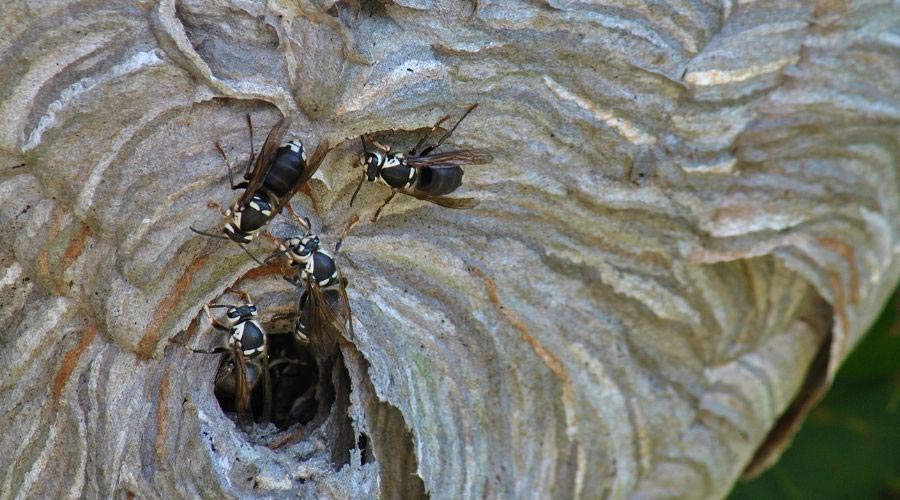
3. Bald-faced Hornets
The bald-faced hornet is called the black-jack, white-faced hornet, bald hornet, spruce wasp, black jacket, and white-tailed hornet. It is, in fact, a wasp that belongs to the same family as yellowjackets.
Colonies can consist of four hundred and seven hundred workers, constructed around hanging paper nests up to fifty-eight centimeters long.
The nests look like a giant gray basketball and are usually attached to the underside of a tree branch or a building. It is generally hidden by the leaves and other components of the tree in wooded areas, and you cannot access it without a ladder.
Workers guard the nest and feed on fruit, tree sap, and nectar. They are particularly fond of the fruit pulp of apples but will also eat other insects and raw meat.
They are white and black, distinguishing them from other yellowjackets, and are common in the southeastern U.S.
These wasps hunt and eat spiders, caterpillars, and flies and are considered beneficial for this reason. Bald-faced hornets respond aggressively to anything that comes too close and will repeatedly sting you.
Bald-faced hornets are not as big as European hornets, and the colony only lives for a season, dying off in the winter. The queen only mates with a single male, and there is often conflict between workers and the queen.
Workers cannot mate, but they can lay eggs that turn into male hornets. Scientists have reason to suspect that after a particular stage is reached in the colony’s development, the workers may kill the queen.
Tips For Dealing With Bald-Faced Hornets
Although sprays formulated for wasps and hornets can be effective, spraying should be done cautiously while wearing protective gear used by beekeepers. Bald-faced hornets can be aggressive when protecting their nest.
If you have an underlying health condition or risk, you could experience anaphylactic shock if stung instead of getting in a professional.
It would be best to treat the nest at night by spraying the insecticide into the opening to avoid disturbing them. To do this effectively, you must get quite close to the nest because you must hold the spray nozzle against the entrance.
It is dangerous to stand at a distance from the nest and spray from there because it may not reach the wasps. They will just become angry, leading to an increased risk of being stung.
The spray should be continuously ejected into the nest until there are no signs of hornet activity. Insecticides for wasps and hornets are also poisonous to humans, pets, and livestock, making sure to follow all safety precautions.
Bald-faced hornets can attack in groups and can sting repeatedly. Since large hornet nests can have up to one thousand hornets, getting rid of them yourself without taking suitable precautions can be extremely dangerous. If in doubt, use a professional.
The hornet’s nest can be around ten or twelve feet off the ground, which may necessitate telescopic poles or other specialized equipment to apply the insecticide. The pain of a sting is significant.
You can place traps near the nest (twenty feet away) to reduce hornet numbers in the nest, making it safer to spray it. It may sometimes be necessary to spray a nest more than once, depending on its size, to ensure that all hornets are dead.
If bald-faced hornets have built their nest in an out-of-the-way area, it is best to leave them alone as they are beneficial to the environment because they prey on other insect pests. They are unlikely to enter your home unless you have many other insects that they consider prey items.
Seal cracks and crevices around plumbing, vents, windows, and doors to prevent insects from entering the house and install yellow bulbs in outside lights to discourage insects.
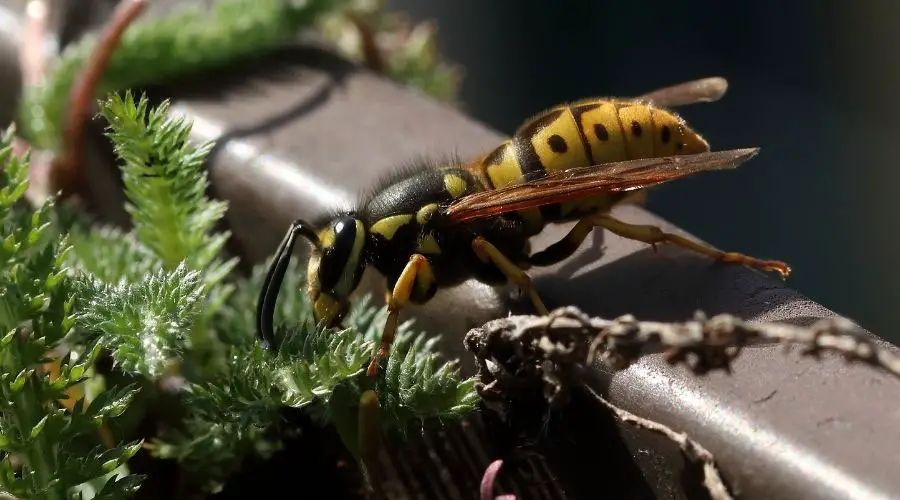
4. Yellowjackets
Yellowjackets are the most dangerous stinging insects in North America. This is due to their unpredictability and secretive nature.
Their nests are usually below ground or within walls, old animal caves, attics, crawlspaces, and buildings’ exterior sidings, making them hard to find and reach.
If the nest is accessible, spraying a wasp and hornet insecticide spray into the entrance to the nest or puffing insecticide dust formulated especially for hornets using bellows can be very effective.
The nest itself is located some way away from the entrance hole in the wall or other part of the building, tree, or burrow; the dust is more effective than the aerosol because it penetrates further.
Attempting to destroy a nest can be hazardous to your health if you don’t do it properly. Treatments should be done at night when most of the wasps are inactive in the nest.
Shining a
It is often hard to know how big a yellowjacket nest is, and putting your eye up to the entrance to find out is not recommended. If the nest is difficult to access or requires a ladder, it is better to call a professional to deal with it.
Yellowjacket colonies reach maturity in early fall, which means their numbers are at a peak as workers forage for food for developing queens.
During this time, the insects they usually prey on are scarce, so they make a nuisance of themselves by invading picnics and outdoor activities in which food is involved. They are more attracted by sweet things but eat just about human food, including meat and fish.
Tips On Dealing With Yellowjackets
- Reducing accessibility of food by keeping picnic drinks and snacks closed or covered until you are ready to eat or drink them;
- Promptly cleaning up spillages, crumbs, and leftovers and putting them in trashcans with tight-fitting lids;
- Locating trash cans and dumpsters far away from tables, doorways, and high-traffic areas in restaurants and fast-food stores.
- Using bin liners in trash cans that make it easy to tie off the trash and regularly emptying trash cans;
- Avoid swatting or hitting the wasp, as this can result in an unnecessary sting. When they are foraging for food, yellowjackets are not as aggressive as they are near their nest and are less likely to sting if left alone.
- Be careful when drinking from soda cans outdoors, as many people get stung in or on the mouth when they don’t realize that a yellowjacket has crawled into the can.
- Leave it alone if the yellowjackets’ nest is out of the way. Nests should only be destroyed if the yellowjackets are dangerous to people or pets around the house. The colony dies off with the onset of cold weather, and the old nest disintegrates. A new nest will be built in the spring.
- Insect repellents that work on mosquitoes and ticks do not repel yellowjackets. It is thus sensible to wear long sleeves and pants when hiking to avoid being stung. Don’t use sweet-smelling perfumes, deodorants, soaps, and shampoos that may attract foraging yellowjackets.
- Trapping the insects in various traps designed for yellowjackets. This is ineffective when wasp numbers are at their peak because there are so many individuals, even though the traps can attract and catch them in large numbers.
Traps have the added disadvantage that you may end up attracting yellowjackets to your home that don’t all get caught in them.
- Place traps in and around fruit trees because yellowjackets are attracted to ripe or rotting fruit.
Conclusions
Hornets can usually be dealt with using insecticides formulated for wasps and hornets if they threaten a home’s inhabitants or employees and customers of a business.
However, the best way to get rid of them is to call in professional pest controllers because they can be dangerous to humans and pets. Removing or containing food sources is essential to ensure that they stay away permanently.
Get FREE quotes from licensed pest control technicians in your area today. Whether you need spraying for ants, roaches, spiders, ticks, mosquitos, or bed bugs, We Can Help! All technicians are screened, licensed, and insured.


